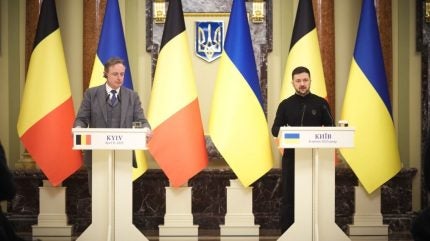
Belgium has pledged a bilateral aid package to support Ukraine, with a commitment to provide €1bn ($1.10bn) annually, starting in 2025.
Prime Minister Bart De Wever announced the decision during a press conference in Kyiv.
The meeting, which included representatives from ten Belgian defence companies, focused on joint arms production and the investment in Ukraine’s defence industry.
Ukrainian President Volodymyr Zelenskyy acknowledged Belgium’s role in reinforcing Ukraine’s air force capabilities, specifically mentioning ongoing efforts to secure F-16 fighter jets.
He said: “This includes defence, political, and humanitarian support, in particular support for Ukrainians in Belgium. But most importantly, at the heart of our partnership is a shared sense of justice. Belgium stands with us in believing in the righteousness of our defence and the injustice of Russian aggression.”
GlobalData’s report indicates that Belgian defence spending is influenced by various factors, with the Ukraine conflict acting as a catalyst for increased government spending.
However, Belgium has emphasised that any escalation in military commitment will depend on heightened cooperation with EU and Nato partners.
De Wever said: “We need to help Ukraine build greater self-defence capabilities and also prepare Europe for potential future aggression from Russia.
“It’s essential that we work together so that the private sector sees attractive opportunities to invest and help expand our collective defence manufacturing capabilities.”
Bart De Wever stated that Belgium is committed to offering consistent military assistance to Ukraine on an annual basis.
During their conversation, the two officials also addressed the topic of sustaining sanctions imposed on Russia.
Earlier in April 2025, reports highlighted a shift in the Ukraine-Russia war, with one-way attack drones now responsible for the majority of combat casualties, surpassing artillery in lethality.
Additionally, Russia’s intensified use of glide bombs, with 10,500 launched into Ukraine in March 2025 alone, signifies an escalation in the conflict’s intensity.


